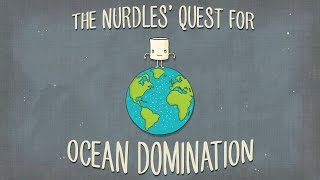(单词翻译:单击)
Meet the nurdles. They may be tiny, look harmless,
介绍一下Nurdles,它们可能很小,看起来无害,
and sound like a bunch of cartoon characters, but don't be fooled.
而且名字听起来像是一群卡通人物,但别被骗了。
These little guys are plotting ocean domination.
这些小家伙正在密谋占领海洋。
Nurdles are some of the planet's most pervasive pollutants, found in lakes, rivers, and oceans across the globe.
塑料颗粒是地球上最常见的污染物,出现在全世界的江河湖海。
The tiny factory-made pellets form the raw material for every plastic product we use.
这些微小的工业颗粒所构成的原材料被用于生产我们使用的所有塑料制品。
And each year, billions of pounds of nurdles are produced, melted,
每一年,无数的塑料颗粒被生产、融化,
and molded into toys, bottles, buttons, bags, pens, shoes, toothbrushes, and beads. They are everywhere.
重塑成为玩具、塑料瓶、纽扣、手提袋、钢笔、鞋子、牙刷和小珠子。它们无处不在。
And they come in many guises, multi-colored and many-shaped,
它们的外表、颜色和形状千变万化,
they range in size from just a few millimeters to mere specks that are only visible through a microscope.
它们可能有几毫米长,也可能是一个只能在显微镜下才能看见的小点。
But their real advantage in the quest for ocean domination is their incredible endurance,
但它们用来占领海洋的真正杀手锏是极强的耐用度,
which allows them to persist in an environment for generations because their artificial makeup makes them unable to biodegrade.
人为加工的过程可以让它们在自然环境中存在无数年而不被降解。
So, just as long as they don't get into the environment, we have nothing to worry about, right?
那么,只要它们不进入自然环境,我们就没有什么好担心的,对吗?
The problem is nurdles have a crafty way of doing exactly this.
问题在于,狡猾的塑料颗粒总能找到进入自然环境的方法。
Produced in several countries and shipped to plastic manufacturing plants the world over,
塑料颗粒一般生产于不同的国家,并被运送到其他地区的塑料制造工厂,
nurdles often escape during the production process, carried by runoff to the coast
在生产过程中,它们可能顺着排放水到达海岸成功脱逃,
or during shipping when they're mistakenly tipped into the waves.
在运输过程中,也可能掉进海里被海浪卷走。
Once in the water, nurdles are swiftly carried by currents,
一旦进入海洋,塑料颗粒会迅速地被水流带走,
ultimately winding up in huge circulating ocean systems called gyres, where they convene to plan their tactics.
最终进入海洋循环系统,就是所谓的环流,邪恶的计划就此展开。
The Earth has five gyres that act as gathering points,
地球上有五大环流,都是塑料颗粒的聚集点,
but the headquarters of nurdle ocean domination are in the Pacific Ocean,
但塑料颗粒海洋侵略计划的总部位于太平洋,
where the comparative enormity of the gyre and the resulting concentration of pollution is so huge
在这里,巨大的环流带来污染的极度集中,
that it's known as The Great Pacific Garbage Patch. Here, nurdles have good company.
故也被称为太平洋垃圾带。塑料颗粒在这里聚集起来。
This gyre draws in all kinds of pollution, but because they don't biodegrade, plastics dominate,
环流也会带来其他种类的污染物,但以无法降解的塑料制品为主,
and they come from other sources besides nurdles, too.
它们不仅仅来自塑料颗粒,也来自其他地方。
You know those tiny beads you see in your face wash or your toothpaste?
比如你的洗面奶和牙膏里的细小柔珠。

They're often made of plastic, and after you flush them down the drain,
它们一般是塑料制的,在你将它们冲入下水道之后,
some also end up in this giant garbage patch, much to the delight of the nurdles, building up their plastic army there.
有一些也会进入这个巨大的垃圾带,使塑料大军更加壮大。
And then there are the large pieces of unrecycled plastic litter,
也有一些未被回收利用的大件的塑料垃圾,
like bottles and carrier bags, transported by runoff from land to sea.
比如塑料瓶和手提袋,顺着河流从陆地到达海洋。
Over time, these plastic chunks turn into a kind of nurdle, too,
一段时间之后,这些大块的塑料也会变成一种塑料颗粒,
but one that's been worn down by the elements, not made in a factory.
但这种塑料颗粒是用于磨损造成的,而非工厂制造。
And as if they weren't threatening enough, the rough, pitted surfaces of these microplastics,
然而更可怕的是,在这些微型塑料,即细小塑料颗粒的粗糙表面,
the name we give to all those collective plastic bits, water-born chemicals stick, or adhere, to them, making them toxic.
会吸附有一些水溶性化学物质,使其变成变成有毒物质。
This gathering has grown so immense that the oceanic garbage patch can shift
这个海上垃圾聚集带正在飞速扩张,
from around the size of Texas to something the size of the United States.
面积从德克萨斯州大小到如今一个美国这么大。
But while this toxic tornado is circulating,
当这些有毒物质随着环流循环,
the birds, fish, filter feeders, whales, and crustaceans around it
生活在附近的鸟类、鱼类、滤食性动物、鲸鱼和甲壳纲动物,
are just going about their daily business, which means they're looking for food.
正在像平常一样活动、捕食。
Unfortunately for them, tiny bits of floating plastic look a lot like fish eggs and other enticing bits of food.
不幸的是,小小的悬浮塑料看起来就像是鱼籽或者其他诱人的食物。
But once ingested, microplastics have a very different and terrible habit of sticking around.
但是一旦被吞下,微型塑料便难以摆脱。
Inside an animal's stomach, they not only damage its health with a cocktail of toxins they carry
在动物的胃里,塑料颗粒所携带的毒性会损害动物体的健康,
but can also lead to starvation because although nurdles may be ingested, they're never digested,
而且还可能会导致饥饿,因为即使塑料小球被吞下,也无法被消化,
tricking an animal into feeling like it's continually full and leading to its eventual death.
只会使动物误认为自己很饱,却最终被饿死。
When one organism consumes another, microplastics and their toxins are then passed up through the food chain.
当有机体被更高等的动物吃掉时,微型塑料和它们的毒性由于富集作用,会顺着食物链传递下去。
And that's how, bit by bit, nurdles accomplish their goal,
这就是塑料颗粒如何一步一步地实现它们侵占海洋的计划,
growing ever more pervasive as they wipe out marine life and reshape the ocean's ecosystems.
它们在消灭海洋生物的同时变得更加强大,甚至重塑了整个海洋生态系统。
So, how to break this cycle? The best solution would be to take plastics out of the equation altogether.
那么,我们该如何阻止这个恶性循环呢?最好的解决办法就是让塑料从世界上消失。
That'll take a lot of time but requires only small collective changes,
这需要很长的时间,但是只需要我们每个人都做出一些小小的改变,
like more recycling, replacing plastics with paper and glass, and ditching that toothpaste with the microbeads.
比如回收塑料制品,用纸和玻璃替代它们,还有丢掉含有柔珠成分的牙膏。
If we accomplish these things, perhaps over time fewer and fewer nurdles will turn up at that giant garbage patch,
如果我们能做到这些,也许假以时日,巨大的垃圾带中的塑料颗粒会越来越少,
their army of plastics will grow weaker, and they'll surrender the ocean to its true keepers once more.
塑料大军的的增长会越来越慢,有朝一日,或许能将海洋重新还给它真正的主人。


